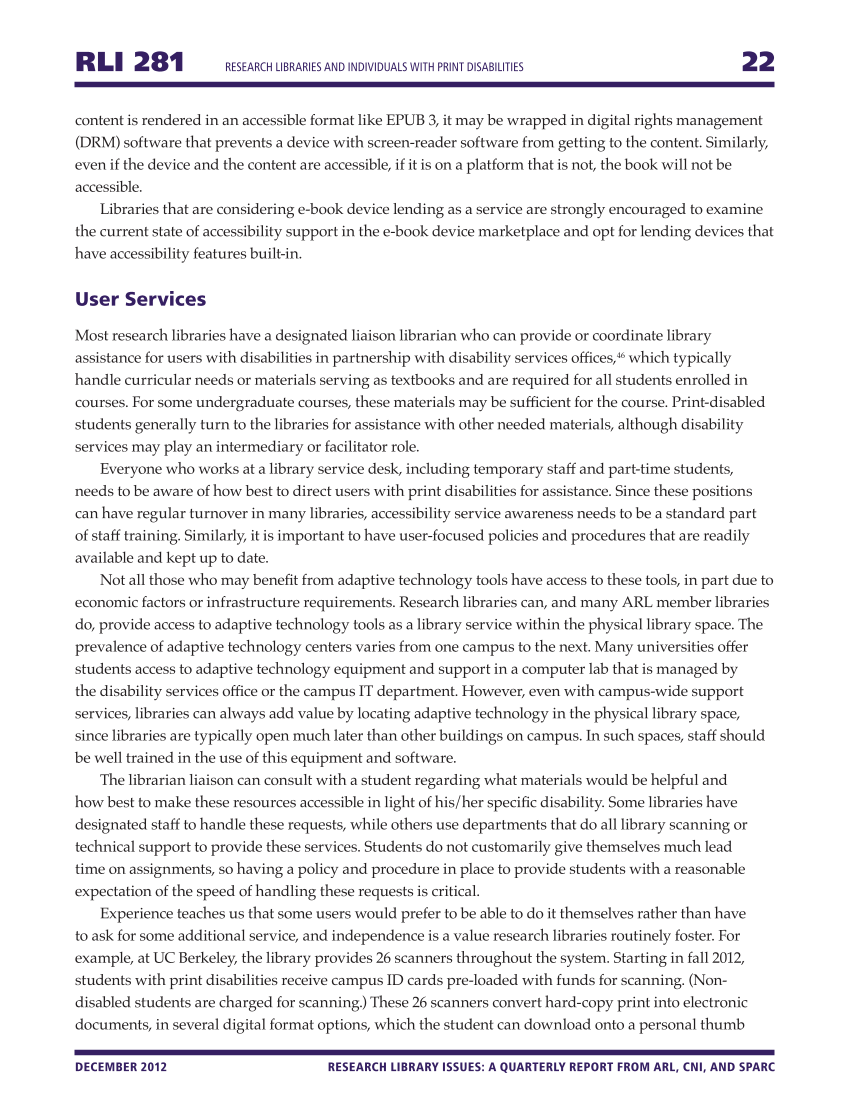RLI 281 Research LibrariesS and IndDividuals with Print DisabilitiesS 22 DECEMBER 2012 RESEARCH LIBRARY ISSUES: A QUARTERLY REPORT FROM ARL, CNI, AND SPARC content is rendered in an accessible format like EPUB 3, it may be wrapped in digital rights management (DRM) software that prevents a device with screen-reader software from getting to the content. Similarly, even if the device and the content are accessible, if it is on a platform that is not, the book will not be accessible. Libraries that are considering e-book device lending as a service are strongly encouraged to examine the current state of accessibility support in the e-book device marketplace and opt for lending devices that have accessibility features built-in. User Services Most research libraries have a designated liaison librarian who can provide or coordinate library assistance for users with disabilities in partnership with disability services offices,46 which typically handle curricular needs or materials serving as textbooks and are required for all students enrolled in courses. For some undergraduate courses, these materials may be sufficient for the course. Print-disabled students generally turn to the libraries for assistance with other needed materials, although disability services may play an intermediary or facilitator role. Everyone who works at a library service desk, including temporary staff and part-time students, needs to be aware of how best to direct users with print disabilities for assistance. Since these positions can have regular turnover in many libraries, accessibility service awareness needs to be a standard part of staff training. Similarly, it is important to have user-focused policies and procedures that are readily available and kept up to date. Not all those who may benefit from adaptive technology tools have access to these tools, in part due to economic factors or infrastructure requirements. Research libraries can, and many ARL member libraries do, provide access to adaptive technology tools as a library service within the physical library space. The prevalence of adaptive technology centers varies from one campus to the next. Many universities offer students access to adaptive technology equipment and support in a computer lab that is managed by the disability services office or the campus IT department. However, even with campus-wide support services, libraries can always add value by locating adaptive technology in the physical library space, since libraries are typically open much later than other buildings on campus. In such spaces, staff should be well trained in the use of this equipment and software. The librarian liaison can consult with a student regarding what materials would be helpful and how best to make these resources accessible in light of his/her specific disability. Some libraries have designated staff to handle these requests, while others use departments that do all library scanning or technical support to provide these services. Students do not customarily give themselves much lead time on assignments, so having a policy and procedure in place to provide students with a reasonable expectation of the speed of handling these requests is critical. Experience teaches us that some users would prefer to be able to do it themselves rather than have to ask for some additional service, and independence is a value research libraries routinely foster. For example, at UC Berkeley, the library provides 26 scanners throughout the system. Starting in fall 2012, students with print disabilities receive campus ID cards pre-loaded with funds for scanning. (Non- disabled students are charged for scanning.) These 26 scanners convert hard-copy print into electronic documents, in several digital format options, which the student can download onto a personal thumb



































